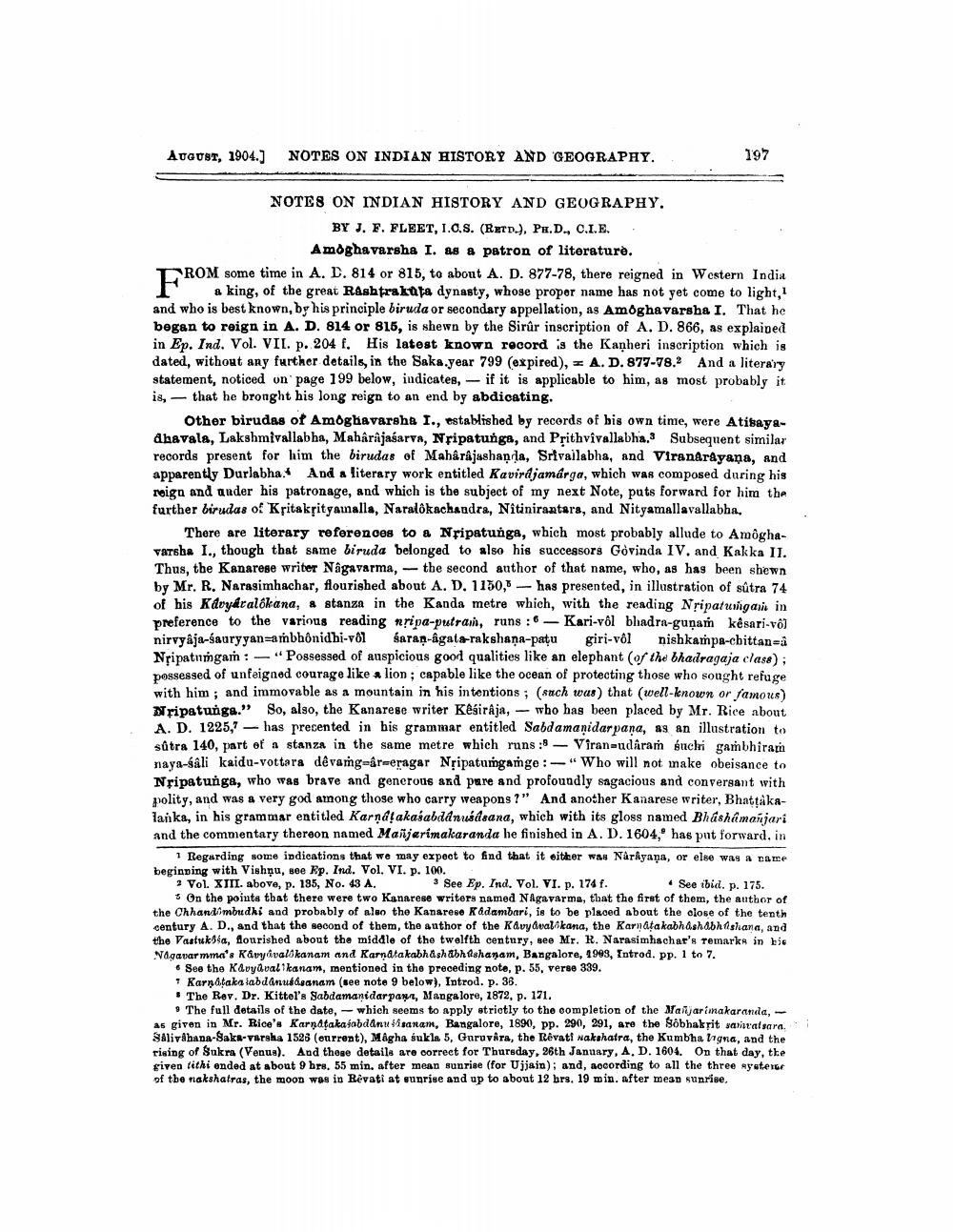________________
AUGUST, 1904.) NOTES ON INDIAN HISTORY AND GEOGRAPHY.
197
NOTES ON INDIAN HISTORY AND GEOGRAPHY.
BY J. F. FLEET, 1.C.S. (RED.), PH.D., C.I.E.
Amoghavarsha I. as a patron of literaturè. T ROM some time in A. D. 814 or 815, to about A. D. 877-78, there reigned in Western India
T a king, of the great Rashtrakata dynasty, whose propor name has not yet come to light, and who is best known, by his principle biruda or secondary appellation, as Amoghavarsha I. That he began to reign in A. D. 814 or 815, is shewn by the Sirûr inscription of A. D. 866, as explained in Ep. Ind. Vol. VII. p. 204 f. His latest known record is the Kanheri inscription which is dated, without any further details, in the Saka.year 799 (expired), = A. D. 877-78.2 And a literary statement, noticed on page 199 below, indicates, - if it is applicable to him, as most probably it is, - that he bronght his long reign to an end by abdicating.
Other birudas ot Amoghavarsha I., established by records of bis own time, were Atibayadhavala, Lakshmivallabha, Mahârâjaśarva, Nripatunga, and Prithvivallabha. Subsequent similar records present for him the birudas of Mahârâjashaņa, Srlvallabha, and Viranarayana, and apparently Durlabha. And a literary work entitled Kavirdjamarga, which was composed during his reign and ander his patronage, and which is the subject of my next Note, puts forward for him the further birudas 0 Kritaksityamalla, Naralokachandra, Nitinirantara, and Nityamallavallabha.
There are literary references to a Nripatunga, which most probably allude to Amoghavatske I., though that same biruda belonged to also his successors Govinda IV. and Kakka II. Thus, the Kanarese writer Nagavarma, - the second author of that name, who, as has been shewn by Mr. R. Narasimhachar, flourished about A. D. 1150,- has presented, in illustration of sútra 74 of his Kdvydralókana, a stanza in the Kanda metre which, with the reading Nripatungait in preference to the various reading nripa-putrain, runs: 6 – Kari-vôl bhadra-guņam kêsari-vôl nirvyája-sauryyanrambhônidhi-vol saran-âgatarakshana-patu giri-vôl nishkampa-cbittanza Nripatungan : -"Possessed of auspicious good qualities like an elephant (of the bhadragaja class); possessed of unfeigned courage like a lion; capable like the ocean of protecting those who sought refuge with him; and immovable as a mountain in his intentions; (sach was) that (well-known or famous) Nripatunga.” So, also, the Kanarese writer Kéáirâja, — who has been placed by Mr. Rice about A. D. 1225,7 — has precented in his grammar entitled Sabdamanidar pana, as an illustration to sâtra 140, part of a stanza in the same metre which runs :8 - Viranşudaram enchi gambhiran naya-sáli kaidu-vottara dêvamg=âr=eragar Nripatumgaṁge :-"Who will not make obeisance to Nřipatunga, who was brave and generous and pare and profoundly sagacious and conversant with polity, and was a very god arnong those who carry weapons ?" And another Kanarese writer, Bhattakalanka, in his grammar entitled Karnatakasabdanuśdsana, which with its gloss named Bhashamanjari and the commentary thereon named Manjerimakaranda he finished in A. D. 1604, has put forward, in
1 Regarding some indications that we may expect to find that it sitter wa Nárkyaņa, or else was a came beginning with Vishnu, see Ep. Ind. Vol. VI. p. 100. 2 Vol. XIII. above, p. 185, No. 43 A.
3 See Ep. Ind. Vol. VI. p. 174 f.
See ibid. p. 175. * On the points that there were two Kanarese writers named Nagavarme, that the first of them, the author of the Chhandimbudhi and probably of also the Kanarese Kadambari, is to be placed about the close of the tenth
tury A.D., and that the second of them, the author of the Kavy avalakana, the Karnatakabhashashishana, and the Vastukssa, flourished about the middle of the twelfth century, see Mr. R. Narasimhachar's remarks in bio Nagavar mma's Kavyával kanam and Karnatakabhashabh Ashanam, Bangalore, 1999, Introd. Pp. 1 to 7.
. See the Kavyavalikanam, mentioned in the preceding note, p. 55, verse 339. 1 Karnataka tabdanulásanam (see note 9 below), Introd. p. 38.
The Rev. Dr. Kittel's Sabdamanidar par, Mangalore, 1872, p. 171.
The full details of the date, which seems to apply strictly to the completion of the Malijarimakaranda, as given in Mr. Rice's Karnatakajabdanu sisanan, Bangalore, 1890, pp. 290, 291, are the Sobhakrit sarratsarai Salivahana-Saka-varska 1525 (ourront), Magha sukla 5, Garuvara, the Revati nakshatra, the Kumbha Igna, and the rising of Sukra (Venua). And these details are correct for Thursday, 26th January, A.D. 1604. On that day, the given tithi ended at about 9 hrs. 55 min, after mean sunrise (for Ujjain); and, according to all the three yeterge of the nakshatras, the moon was in Revati at sunrise and up to about 12 hrs. 19 min. after mean sunrise




